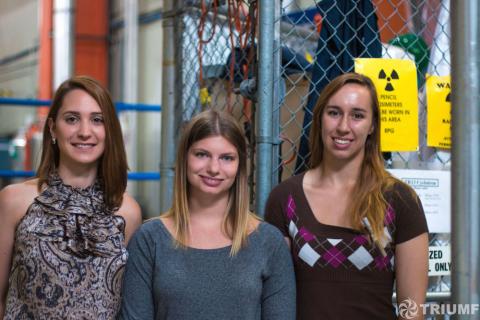
How does a physician image a cancer that does not respond to common techniques?
This is the question that Thompson Rivers University co-op student Carlee Poleschuk hopes to answer during her 8-month work term at TRIUMF. In collaborating with the Nuclear Medicine team at TRIUMF and the British Columbia Cancer Agency (BCCA), Poleschuk uses isotopes to test alternative imaging agents that can help diagnose Triple Negative Breast Cancer (TNBC).
“There’s this strain of breast cancer: hard to diagnose, poor prognosis, hard to image,” said Poleschuk of the disease. She explained that this is due to the cancer cells’ lack of known receptors. Receptors help clinicians recognize, diagnose and treat certain types of diseased tissue by binding to and then bringing molecules into the cell.
Welcoming a “familiar face”
Dr. Paul Schaffer, head of nuclear medicine at TRIUMF, helped clarify how the molecules use receptors to enter the cell. “It’s much like our ability to recognize familiar faces that come knocking on our front door,” he said. “If we don’t recognize a stranger at the door, we won’t want to let them into the house.” Essentially, if the receptors do not recognize the molecules used in imaging agents or therapeutic drugs, they will not be taken up into the cell.
As TNBC does not have the receptors commonly used to diagnose or treat breast cancer, Poleschuk stated, “It is difficult to do [any] targeted therapy.” She continued, “That’s why it’s very difficult to diagnose and treat. There’s essentially no way to bring the treatment into the cell.”
This prompts the question around which her project is focused, “How do we find a way to image it so that we can see which [treatments] will actually work?”
Poleschuk is looking towards a tracer that is identifiable with Positron Emission Tomography (PET):18F-5-fluoroaminosuberic acid.
PET typically involves the injection and imaging of a radioactive sugar. This is used to identify cells that are working at an enhanced metabolic rate, which is a hallmark of cancer. However, Poleschuk and her team have found that aminosuberic acid (ASu), rather than glucose, has a higher uptake with TNBC. This increased uptake is directly related to the amount of the cystine transporter protein that is found in the cell, as a result of high oxidative stress.
The search for equilibrium
Oxidative stress occurs when there is imbalance between antioxidants and reactive oxygen species, which, as Poleschuk explains, is “anything with a lone electron.” The imbalance signals the nucleus to produce more of the cystine transporter. “This transporter makes antioxidants,” said Poleschuk. “Antioxidants react with oxidative stress to neutralize it, essentially. It’s like the body’s natural protection.”
“Normal cells that have an equilibrium … will have very low amounts of this protein,” continued Poleschuk. “Whereas the higher oxidative stress you have, the more this protein you have, so the more uptake of this tracer you have.”
This increased uptake is due to the similarities between the cystine transporter protein that is being brought into the cell and the ASu. Poleschuk said, “If the cell can’t distinguish between the natural molecule and the molecule that we’ve made, it’ll take it up.” This means that they will be able to use PET to understand what is happening within the cell.
What's next?
Poleschuk is now set on determining the specific system that takes in the tracer and verifying that it is present in TNBC. If her hypothesis is supported, doctors could potentially use PET to better understand this particular type of cancer.
She has been working under the supervision of Schaffer at TRIUMF, where the tracer is made and labeled, and Dr. François Bénard at the BCCA, where preclinical testing and data analysis is conducted. The 110-minute half-life of the tracer requires excellent collaboration and communication between the two institutions. “On the day of testing, [we have to] be outside, ready for the tracer at the right time,” said Poleschuk. “It takes a couple of weeks to plan each experiment.”
As Poleschuk continues the second half of her term at TRIUMF, she looks forward to being an author on a report detailing the progress that has been made towards imaging this cancer. She expressed that this work is vital for “personalized medicine, which is a key aspect of what a lot of doctors are moving towards.”
Poleschuk, who will be returning to Thompson Rivers University in September to complete her BSc in Chemistry and Biology, says her time at TRIUMF has, “opened her sights to new [career] paths.” She shared that nuclear medicine had not been on her radar prior to her work term, but it is now the main course for what she would like to do.
- Kelsey Litwin, Communications Assistant
Preliminary interview conducted by Jacqueline Wightman
Photo: Poleschuk (centre) stands with students Milena Colovic (SFU, left) and Marina Lazarakos (University of Guelph, right) who work alongside her in TRIUMF's Nuclear Medicine division to develop novel tracers.
